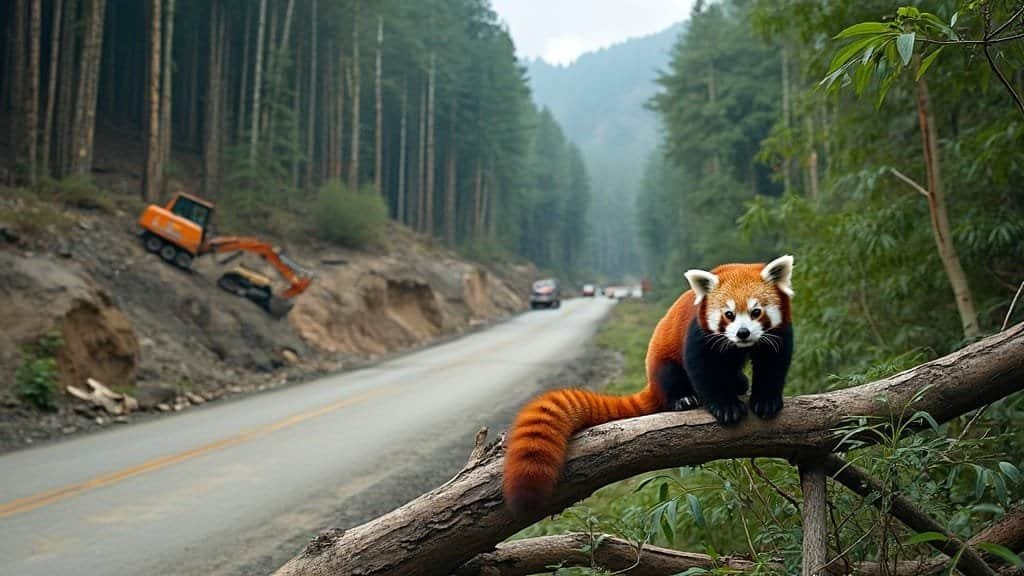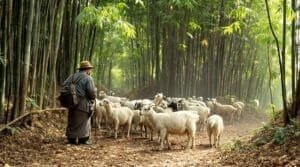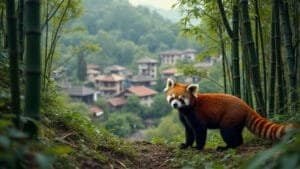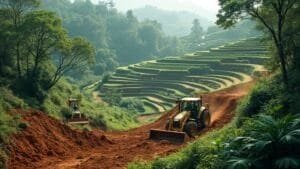As road networks expand across the mountainous regions of Asia, the red panda—an already vulnerable species—faces escalating threats to its survival. What role do road developments play in the decline of red panda populations? The answer lies in the complex interplay between habitat fragmentation, human encroachment, and environmental degradation
This article explores how road construction disrupts red panda territories, affects their behavior, and fragments their gene pools. It also delves into the secondary consequences of increased access—such as poaching and overharvesting of bamboo—and evaluates current conservation strategies aimed at mitigating these impacts
From the dense forests of Nepal to the slopes of the Eastern Himalayas, we’ll examine the scientific evidence and expert insights that reveal just how much a road can reshape the fate of a species
Impact of Road Developments on Red Panda Habitats
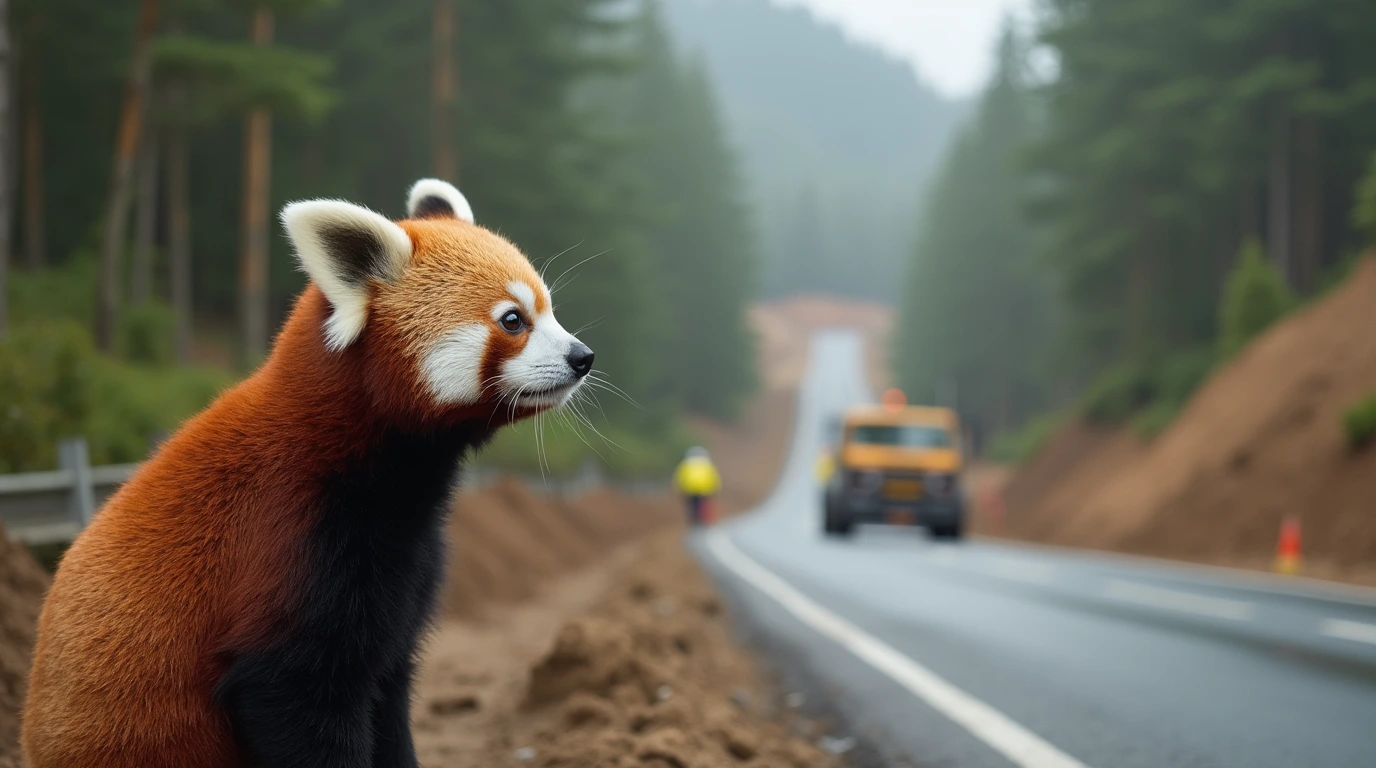
As infrastructure projects push deeper into forested regions, the red panda faces mounting ecological pressures that threaten its survival. Road construction, in particular, has become a significant environmental stressor. The impact of road developments on red panda habitats is far-reaching, altering the landscape and undermining the stability of red panda populations across Asia’s mountainous terrains
Fragmentation of Red Panda Territories Due to Road Construction
Red pandas inhabit temperate forests in the Eastern Himalayas and southwestern China, relying heavily on undisturbed, contiguous forest cover for foraging, nesting, and movement. Road construction bisects these forests, creating physical barriers that fragment the landscape into isolated patches. According to a 2021 study published in Movement Ecology, red pandas are particularly sensitive to such changes, avoiding areas within close proximity to roads and cattle stations. This behavior limits their access to critical resources and reduces home range sizes, which typically span from 0.3 to 1.9 square miles depending on habitat quality and population density
Fragmentation doesn’t just confine red pandas to smaller areas—it disrupts ecological connectivity. Isolated subpopulations are at greater risk of inbreeding, which can lead to reduced genetic diversity. A loss in genetic variation has direct implications for disease resistance and adaptability, crucial factors for the species’ long-term survival. The Red Panda Network has reported that the Panchthar-Ilam-Taplejung corridor in Nepal—once a continuous habitat—is now broken into over 400 patches due to infrastructural development, reducing gene flow and increasing vulnerability to local extinction events
The spatial disconnect also hampers juvenile dispersal. Young red pandas, which naturally venture away from their birthplace to establish new territories, find themselves blocked by roads, increasing mortality risks and reducing reproductive success. Studies such as those by Bista et al. (2023) in Mongabay emphasize that these human-induced barriers may be pushing populations toward unsustainable isolation
Behavioral Changes Triggered by Proximity to Roads
The behavioral response of red pandas to roads further illustrates the toll infrastructure takes on their welfare. Equipped with GPS collars, red pandas monitored by conservation biologist Dr. Damber Bista and his team revealed consistent avoidance patterns: they spent significantly less time in areas near roads and human settlements, shifting their activity toward more secluded forest cores
Stress-induced behaviors include increased movement speeds and changes in daily activity patterns. For example, pandas that ventured near human tracks or roads tended to move faster—presumably to minimize exposure—resulting in higher energy expenditure. This adaptation is not without cost; the added energy demand can lead to nutritional stress, particularly in bamboo-dominated habitats where food resources are patchily distributed
Such stress responses also coincide with altered foraging efficiency. By avoiding optimal feeding grounds near human infrastructure, red pandas may consume less or lower-quality bamboo, affecting their health and reproductive capabilities. The Movement Ecology journal further corroborates this, reporting that red pandas in road-adjacent areas showed decreased site fidelity and home range stability
These behavioral changes are not merely reactive—they represent a long-term shift that reduces the ecological carrying capacity of affected regions. The changes suggest a landscape increasingly unsuitable for sustaining viable red panda populations, where fear and fragmentation dictate daily survival strategies
Geographic Hotspots Where Roads Threaten Red Pandas Most
Geographically, the threat of road-induced habitat loss is most pronounced in the Eastern Himalayas, particularly in Nepal and northeastern India. In Nepal, the road-building boom in districts like Ilam, Panchthar, and Taplejung—key habitats for the red panda—has carved through forest corridors that once supported wide-ranging movements. The Red Panda Network highlights this region as a critical conservation area where nearly 70% of Nepal’s red panda population resides, yet it is now heavily fragmented
In Arunachal Pradesh, India, road construction as part of national infrastructure projects has opened up previously inaccessible areas, further encroaching into red panda habitats. These regions not only contain the highest red panda densities but also serve as ecological bridges between subpopulations across national borders
The urgency of protecting these hotspots lies in their role as biodiversity corridors. Disrupting them doesn’t just impact red pandas; it reverberates through the entire montane ecosystem, affecting other endemic species and ecosystem services. The insights provided by researchers such as Bista in Mongabay help illustrate how local communities and policymakers are attempting to balance development with conservation, including projects like buffer zones and forest restoration initiatives
To explore additional insights on this topic, you can refer to the article on Red Panda Network’s road-related conservation efforts which provides a detailed look at region-specific impacts and mitigation strategies
Human-Induced Threats Amplified by Road Networks

The expansion of road infrastructure through red panda habitats introduces a cascade of secondary threats beyond mere habitat fragmentation. While roads physically divide forest corridors, they also facilitate human intrusion, intensifying the pressures on red panda populations. These include elevated risks of poaching, resource exploitation, and degradation of critical food sources like bamboo. As a result, roads act as amplifiers of anthropogenic threats, placing red pandas in increasingly hostile and unstable environments
How Roads Enable Poaching and Illegal Wildlife Trade
Roads significantly increase the accessibility of previously secluded forested areas, enabling poachers to penetrate deep into red panda territory. This increased access has coincided with a notable uptick in illegal wildlife trade, especially in eastern Nepal. The Red Panda Network reports that areas like the Panchthar-Ilam-Taplejung corridor—once naturally protected by their remoteness—have become prime targets due to new roads that cut through habitat strongholds
Red pandas are poached for their fur and are trafficked live for the exotic pet trade. Roads allow poachers to operate more efficiently, using vehicles to reach and exit poaching sites quickly, which reduces the chances of detection and arrest. Moreover, with up to 90% of wildlife crimes going unreported in Nepal, enforcement lags far behind the speed of road-facilitated poaching operations
These routes are not only used for hunting but also function as transport corridors for smuggling animal parts across borders, particularly to China and India. This transboundary dimension compounds the challenge, as monitoring and enforcement require international cooperation, which is often slow and under-resourced. In this context, road construction becomes a vector not just for development, but also for accelerating illegal trade networks that exploit red panda populations
Road-Induced Habitat Changes and Red Panda Reproduction
The presence of roads has also been shown to negatively influence red panda reproduction. Road-induced fragmentation reduces the availability and continuity of core breeding habitats, which are essential for mating, denning, and raising cubs. Smaller, isolated forest patches often lack the ecological integrity needed to support healthy red panda populations, and limited access to potential mates increases the risk of inbreeding
A 2024 study in Science of The Total Environment links habitat fragmentation with decreased reproductive success, highlighting that female red pandas may struggle to find secure and undisturbed nesting sites near road-affected zones. Even minor disturbances—such as noise from vehicles or increased human foot traffic—can lead to den abandonment, lower cub survival, and elevated stress levels in mothers
Given red pandas’ solitary nature and relatively low reproductive rate—females typically give birth to only one or two cubs per year—any reduction in breeding success has long-term implications for population stability. Road development, therefore, doesn’t just affect where red pandas live; it directly impacts whether they can continue to reproduce successfully in those environments
Bamboo Availability Affected by Increased Human Access
Bamboo forests, the cornerstone of the red panda diet, are also at risk due to increased human access enabled by roads. With greater reach into forest interiors, communities often harvest bamboo for construction, firewood, and livestock fodder. In areas where red pandas rely almost exclusively on bamboo leaves and shoots, this depletion poses a major ecological threat
Research from Movement Ecology (2021) shows that red pandas modify their behavior to avoid areas of high human and livestock activity. This means they are increasingly restricted to smaller patches of bamboo in deeper forest areas, often further from roads but less abundant or nutritionally rich. The combined effects of reduced bamboo availability and increased foraging competition may lead to energy deficiencies and poor health outcomes, especially during the winter when bamboo is scarce
Moreover, livestock brought in via road access competes with red pandas for bamboo and often causes physical degradation of undergrowth. Trampling, browsing, and grazing reduce regeneration rates of bamboo, leading to a long-term decline in the quality and quantity of food available
For more insights into how road construction intensifies human threats to red pandas—including field-based evidence and interviews with leading researchers—refer to this Mongabay article featuring Dr. Damber Bista, which outlines how roads intersect with poaching routes and habitat degradation in eastern Nepal
Conservation Measures to Mitigate Road Impacts

As road expansion continues to challenge red panda survival across the Himalayan region, conservation responses are evolving to mitigate these impacts. Strategies range from infrastructure solutions like wildlife crossings to grassroots restoration and anti-poaching programs. These efforts, often led by local communities and NGOs, are grounded in both ecological research and social collaboration
Wildlife Crossings and Structural Solutions for Connectivity
Wildlife crossings, such as overpasses and underpasses, are gaining traction as essential tools to counteract the barrier effects of roads. While there are few documented examples of these structures specifically designed for red pandas, ecological evidence from similar forest mammals suggests they can significantly enhance habitat connectivity. These crossings are often designed with dense vegetation and minimal noise intrusion to encourage usage by shy, arboreal species like the red panda
In Nepal and northeastern India, conservationists are advocating for the integration of wildlife passages into new road infrastructure projects, particularly in areas identified as red panda corridors. These structures are most effective when paired with fencing to guide animals toward safe crossing points and reduce the risk of vehicle collisions. As more roads are proposed in red panda habitats, incorporating these mitigation features early in the planning stages is becoming a key recommendation in environmental impact assessments
Efforts are also underway to apply lessons learned from other endangered species to red panda conservation. In ecosystems where similar fauna have benefited from such crossings, population connectivity has improved, and mortality rates from roads have dropped significantly. As these approaches evolve, they hold promise for red panda populations increasingly confined by road-induced fragmentation
Community and NGO Efforts in Red Panda Habitat Restoration
Conservation organizations are working hand-in-hand with local communities to reverse the effects of habitat fragmentation. The Red Panda Network leads one of the most comprehensive habitat restoration efforts in the region through its “Plant A Red Panda Home” campaign. This program focuses on restoring native forests and bamboo groves, which are vital for feeding, nesting, and movement
Community-based forest user groups are central to this work, managing reforestation zones and helping maintain forest corridors that have been dissected by road projects. These efforts not only create continuous forest cover but also provide economic benefits to local people through employment and eco-tourism opportunities. This community stewardship is key to ensuring long-term protection, as it shifts the incentive away from forest exploitation and toward sustainable land use
To gain a clearer picture of how these landscape-scale efforts are being implemented, the Red Panda Network offers a detailed overview of its corridor projects in Nepal. You can explore their strategy and the ecological rationale behind these initiatives in this informative article on red panda corridor conservation, which highlights how reforestation is helping to reconnect fragmented panda populations across road-impacted habitats
Protected Areas and Anti-Poaching Strategies in Practice
Protected areas remain vital in red panda conservation, acting as strongholds against expanding roads and development. National parks in Nepal, India, and Bhutan safeguard large tracts of red panda habitat and restrict major infrastructure projects. However, physical protection alone is not enough. Poaching remains a persistent threat, especially in road-accessible regions
To counter this, NGOs and wildlife departments have intensified anti-poaching patrols, often enlisting local volunteers. Programs like the Forest Guardians, also coordinated by the Red Panda Network, train residents to monitor wildlife, document illegal activity, and report signs of encroachment. These guardians form a frontline defense in remote areas where formal enforcement is limited
Advanced technologies such as camera traps, satellite monitoring, and GPS collaring also assist in tracking panda populations and detecting risks from encroachment or degradation. These data-driven tools are essential for adjusting protection strategies in real-time and identifying priority zones for intervention
In combination with the habitat restoration efforts described above, these measures are beginning to yield results, helping buffer red pandas from road-related threats while promoting long-term species recovery. By addressing both the direct and indirect consequences of road development, conservationists are building a foundation for coexistence between infrastructure expansion and wildlife protection
